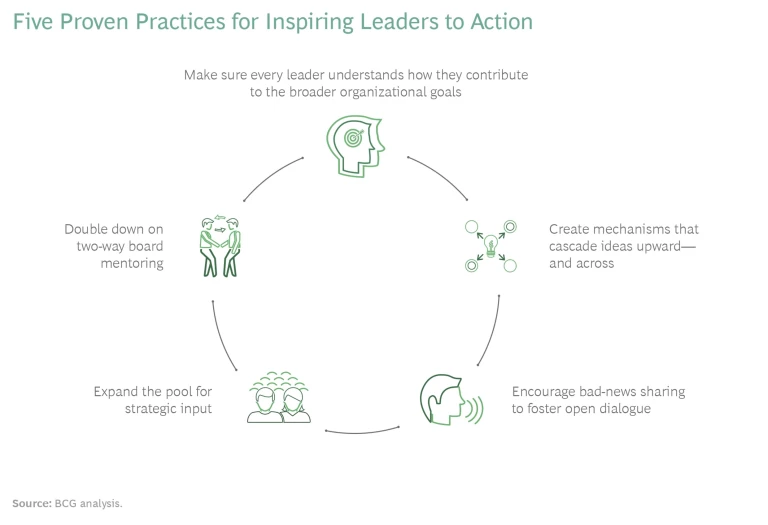Five key practices can unify leaders up, down, and across the organization—and spark concerted action.
For many companies, uniting leaders to carry out the organizational agenda is a struggle. Even before COVID, management had a hard time getting on the same page and pulling in the same direction, and leading remotely only made things more difficult. Moving away from a siloed, hierarchical culture to a fail-fast, “we’re all-in-this-together” one often remains elusive.
To drive performance and innovation, leaders across the organization must be crystal clear about strategic priorities—and about translating them into action in a coordinated way. Indeed, according to BCG’s 2021 global transformation survey of 3,000 senior leaders, transformations in which leaders were unified on the rationale and goals were 77% more likely to be successful than those in which leaders had less cohesion.
When the CEO asks at the end of a meeting, “Are we aligned?” everyone typically nods. But more often than not, the actions people take later don’t match the direction they previously agreed on. A better question would be, “Are we all prepared to row in the same direction?” That is, are we, as company leaders, ready right now to carry out with our teams the decisions necessary to put our agenda into action?
In an era of exponential change, ensuring unity in action—what we often call leadership “activation”—is a formidable challenge for businesses. But it is imminently achievable. In this article, we crystallize key reasons for the disconnects. Then we describe a set of proven practices that can help companies inspire and activate leaders up, down, and across the ranks to advance goals in unison.
Why the Lack of Cohesion?
In our experience, leaders can generally agree on an overall direction and set of priorities for their organization. They can recite the vision, organizational strategy, and key metrics at will. But ask leaders two or three levels below the C-suite how their department is contributing to the company’s performance goals, and most can’t give a clear answer.
If middle managers aren’t on the same page with each other and with senior leaders from the start, how can they possibly be expected to act cohesively in the face of rapid change and the often unprecedented challenges that arise? Being unified in action isn’t just a transformation imperative; it matters equally in business-as-usual mode (although the boundary between the two states is increasingly blurring). In their everyday management routines and practices, leaders need to be on the same page and working toward the same overarching goals.
In their everyday management routines and practices, leaders need to be on the same page and working toward the same overarching goals.
So, why the lack of cohesion? We’ve observed three main reasons:
- Unifying leaders is an intermittent exercise. Instead of being a continuous effort, unifying leaders is something that’s often left to the offsite (or worse, treated as an afterthought in the post-offsite email). The process also tends to be focused on merely aligning leaders and not on spurring them to act. In some cases, participants come away with different takes on the proceedings, and their subsequent messaging to their teams is inconsistent and confusing. Often, time constrained senior executives take shortcuts. It’s easier to forward a communications deck to your direct reports than to sit down with them to get consensus on key priorities.
- A key group of leaders—middle managers—gets stuck. Those first few layers beneath the executive leadership team (ELT) frequently struggle to translate ideas into the right type of action. This difficulty can spring from a range of causes. Even the most gung-ho and aligned ELT might be sending mixed signals or issuing ambiguous communications that get lost in translation. As a result, the middle managers simply get it wrong. More often than not, though, managers opt for inaction because change is uncomfortable. Or because taking action might get them into trouble and it’s safer to do nothing. (Such an attitude is, of course, contrary to what we expect of leaders.) Beyond hampering company progress, a reluctance to take action can ultimately impede individuals’ career advancement as well as undermine the company’s leadership development efforts.
- There are no mechanisms for ensuring and sustaining alignment up, down, and across. The sheer size and complexity of large organizations hinders information flow and individuals’ access to different leadership layers. Without bottom-up communication (vertical alignment), the C-suite and ELT often miss out on insights from middle managers who have a frontline view—whether it’s feedback about client dissatisfaction, a promising new product idea, or a fresh perspective on the business’s go-to-market strategy. Without cross-business interaction (horizontal alignment), managers are likely to pursue the best outcome for their own team at the expense of the greater good. When coordination across functions is lacking, a wealth of initiatives can make it hard for overwhelmed leaders to stay focused on top priorities.
Five Proven Practices for Activating Leaders
How do companies overcome these roadblocks to inspire unity and move leaders to action? We’ve identified five proven ways. (See the exhibit.)

Make sure every leader understands how they contribute to the broader organizational goals. Unifying senior executives around the overarching goals is not the biggest problem. Rather, it’s that managers below the senior executive team often don’t know how to translate those goals to their area of responsibility. For example, what must they do to contribute to return on capital? When there is little clarity about what the broad goals mean to their area of responsibility, managers might focus selectively on the functional issues in their purview rather than on the broader business outcomes. Ambiguity reinforces itself, ultimately undermining leaders’ effectiveness in tackling the greater priorities.
To combat this tendency—and to create cross-enterprise unity—leaders should pursue shared business outcomes in addition to their individual ones, adopting metrics that are transparent to their individual area (and possibly to the broader enterprise). Objectives and Key Results metrics, if used correctly, can be effective in doing this. For example, at an offshore oil drilling company, instead of focusing only on individual functional goals such as boosting drilling speed or finding the greatest number of oil prospects, regional operations leaders might zero in on managing total development costs. This shift would encourage leaders to work together and make tradeoffs: drilling the right prospect at the right speed to achieve the lowest development cost.
Create mechanisms that cascade ideas upward—and across. Often, some of the best thinking comes from people lower down in the organization. Without a way for good ideas to flow upward or across silos, companies can end up stumbling over otherwise foreseeable hurdles—or losing out on groundbreaking ideas. Conversely, when those in the middle feel empowered to offer their views on others’ decisions, behavior, or performance (whether those others are C-suite executives or peers), they become invested and empowered. In other words, they take on the mantle of leadership and are motivated to act.
Without the involvement of a broader forum of leaders, the C-suite and board risk operating in an echo chamber, insulated from fast-changing developments on the ground, such as market influences, changing customer preferences, and new technological developments. One company, a luxury fashion retailer, established a shadow board of about 15 younger managers to challenge the ELT’s thinking. These high potentials were charged with confirming the company’s strategic alignment with current market trends. In a short amount of time they helped the company adapt its marketing strategy to focus on trends that would appeal to younger generations.
Peer-to-peer idea sharing can happen in a number of ways. A sales team leader, for instance, can sit in on the marketing team’s strategic meetings to gain a better understanding of their goals and issues, and vice versa. One leading supermarket chain conducts weekly calls in which store managers share direct customer feedback, operational challenges, and best practices for making improvements. This same store embraces shadowing as a means of peer-to-peer learning. A group of managers from an underperforming store will spend a half day with their counterparts at a “champion” store in their region to see what they’re doing right. Managers often participate in Reddit communities to share information about problem solving and dealing with new responsibilities.
Stay ahead with BCG insights on people strategy
Encourage bad-news sharing to foster open dialogue. Sharing bad news—top-down, bottom-up, and across the organization—has a number of salutary effects beyond the obvious benefits of transparency. It can elicit empathy and support, break down barriers, and expand the pool of contributors to problem solving. Energy otherwise spent saving face can be channeled into more constructive use. The net result is not just top-down, bottom-up alignment, but stronger horizontal alignment. As with the idea of encouraging risk taking and “failing fast,” bad-news sharing will only take root if the CEO and ELT practice it themselves.
Instead of asking ELT members to summarize how they are doing (which usually only yields positive reports), one CEO we know focuses the conversation on “What keeps you up at night?” At executive team meetings, she asks her direct reports to share their biggest challenges. Then as a team ELT members help one another by sharing ways they have successfully overcome such challenges. This approach encourages leaders deeper in the organization to ask the same question of their direct reports and of their peers. As a result, people raise concerns and surface problems earlier.
Expand the pool for strategic input. If seeking important feedback from a wider leadership group promotes alignment, why not go one step further and solicit strategic ideas? Participation in leadership meetings that’s limited by reporting lines deprives the company of important intel and fresh thinking that can help leaders be more effective. To improve unity across the business, include relevant voices from other layers and adjacent roles. Invite top performers and those with deep knowledge of a market, trend, or new technology. In addition to injecting frontline expertise into discussions, this practice ensures more diversity of thought and thus more creative thinking. It’s also a way to reach out to diverse colleagues to get their input.
A major retailer in a narrow, competitive sector needed to amp up its performance and adopt a “stretch” culture to surpass its rivals. The CEO recognized that the best way to accomplish this would be to rally a broader swath of leaders. Beyond the usual annual effort, he established an extended strategy development process. It involved the entire senior leadership team—the ten-member ELT, their direct reports, and managers two layers down—being engaged in the six-month-long process. Activities have included a two-day war-gaming exercise, formal and informal engagements and get-togethers, and a challenge in which executives posed the question, “What would it take for us to go from a $120 billion company to a $200 billion one without opening any new stores?” Among the many ideas participants put forth was adding maintenance and repair services to the company’s offerings. Including this broader group not only added more voices to the discussion, it also guaranteed new voices, thanks to promotions and recent hires.
Double down on two-way board mentoring. At most organizations, board members serve in the traditional role of fiduciary governance and oversight. In our view, they are underutilized: with all the power of their collective and diverse industry and leadership experience, they can play an important role in helping companies unify and develop their leaders.
The CEOs of several leading Fortune 500 companies have enlisted board members to each mentor two or three high-potential senior managers (junior ELT members or their direct reports). The mentees gain from their mentors’ decades of experience and broad perspective. As outsiders, the board members can provide an unclouded view of these promising managers’ abilities and help them overcome any handicaps to advancement. (See “Board Mentors Can Help Talent Shine Through.”) Board members benefit, too: Apart from gaining a deeper view of the organization and their protégés’ area, they get exposed to another generation of business managers—individuals who are part of the ascendant generations shaping the future.
Board Mentors Can Help Talent Shine Through
Recognizing her otherwise stellar qualities, the board paired her with a board member for coaching help and assigned her more chances to present to them. The board leader helped her prepare for her presentations, including thinking through the questions she would likely be asked. Thanks to these measures, she made dramatic improvement, and she and the company were ultimately able to take advantage of her full leadership potential.
Mentoring ought to work both ways. Because board members can’t come from competitor organizations, they often lack a nuanced understanding of the company’s operations or of current industry realities. This can hinder their ability to advise the CEO and ELT in the most effective way. Reverse mentoring board members gives those leaders a deeper exposure to the business. Consider having board members tour the business premises with company leaders. Use annual board meeting offsites to orient new members and offer current members refresher briefings on the business. Such reverse mentoring is beneficial in all areas of the organization, and companies should seek as many opportunities as they can to implement it.
Greater agility, less bureaucracy, and more-distributed decision making can only happen when those at the top are unrelenting in their efforts to unify company leaders and spur them into action.
These benefits go beyond merely developing the next level of leadership talent and equipping board members to be more effective. If done right, two-way mentorship can turbocharge the implementation of the other four practices: It can help ensure that the selected managers understand how they tangibly contribute to the broader organizational goals. It can create a direct path for cascading ideas upward. It can foster open dialogue and bad-news sharing with those in the top echelons of the organization. And it can provide a vehicle for managers to offer strategic input to those who ultimately need to endorse the company’s strategy.
Competing today calls for greater agility, less bureaucracy, and more-distributed decision making. To realize these strengths, company leaders need to row in the same direction, anticipating and navigating rough seas and shifting currents. This can only happen when they are unrelenting in their efforts to unify leaders and spur them into action. The practices described here, embraced by many of the world’s top-performing organizations, can help others rally leadership up, down, and across the company—and get the best from all of its leaders.




